Google made huge strides this fall in the hardware sector, most of it as a push to get its new digital assistant, dubbed the Google Assistant, into the world.
There is no doubt the Pixel, Google’s first ever smartphone, is a monumental device in the history of the industry, but the more important gadget for Mountain View might be its Amazon Echo competitor, the Google Home. At $130, it’s the most affordable entry into a world with Google Assistant and, unlike the Pixel, it is all about the Assistant.
Amazon may have a healthy head start in the connected speaker hardware category, but Google could quickly gobble that lead up thanks to its superior data and all-in bet on AI. A year from now, the Home could be the biggest and best name in the category Amazon invented, but it won’t ever be if it stumbles out of the starting gates.
Unfortunately, for Jeff Bezos and company, it does not.
 Since it was first unveiled at I/O earlier this year, Google Home has been the victim of relentless teasing about its looks. Many say it resembles an air freshener, and they’re not wrong. The first thing my girlfriend said when I showed her our new connected speaker was just that: it looks like an air freshener.
Since it was first unveiled at I/O earlier this year, Google Home has been the victim of relentless teasing about its looks. Many say it resembles an air freshener, and they’re not wrong. The first thing my girlfriend said when I showed her our new connected speaker was just that: it looks like an air freshener.
But though it may seem inelegant for an intelligent new piece of technology to be the visual sibling of something you plug into a wall and forget about, with Google Home it’s fitting. The speaker is meant to blend into your existing setup, and it does that better than its main competitor, the Amazon Echo.
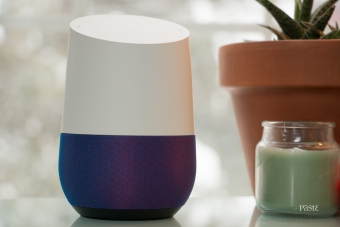 Where the Echo is tall and slender, and looks far more futuristic, echoing 2001: A Space Odyssey a bit too much, Home is downright cute by comparison. I love the look. It’s inviting and friendly, making you want to interact with it rather than feeling like it’s watching you.
Where the Echo is tall and slender, and looks far more futuristic, echoing 2001: A Space Odyssey a bit too much, Home is downright cute by comparison. I love the look. It’s inviting and friendly, making you want to interact with it rather than feeling like it’s watching you.
 It’s not huge, smaller than most of the glassware in my apartment, and you can choose different bases to help match it to your decor. The bases are affordable, $20 for the fabric options and $40 for the metal choices, and are easy to switch out. It took me five seconds to replace the standard base for the more colorful, violet option.
It’s not huge, smaller than most of the glassware in my apartment, and you can choose different bases to help match it to your decor. The bases are affordable, $20 for the fabric options and $40 for the metal choices, and are easy to switch out. It took me five seconds to replace the standard base for the more colorful, violet option.
The connected speaker is well-built, though it won’t have to go through the same kind of daily turmoil that your smartphone would. For the most part, you’ll rarely touch it beyond the initial setup. That’s the whole idea of the device, to interact with it through your voice. You can touch the Home for various things through the panel on the slanted top of the device. You can tap it to get the Google Assistant’s attention, pause and play music, stop a timer and various other controls, and you can slide your finger across to adjust the volume. In my experience, it works well even if they’re not the most accurate of touch controls.
Save for the design, which is quite important for a device you are going to give a permanent spot on a shelf or table in your house, the most important hardware features of the Home are the microphones and speaker.
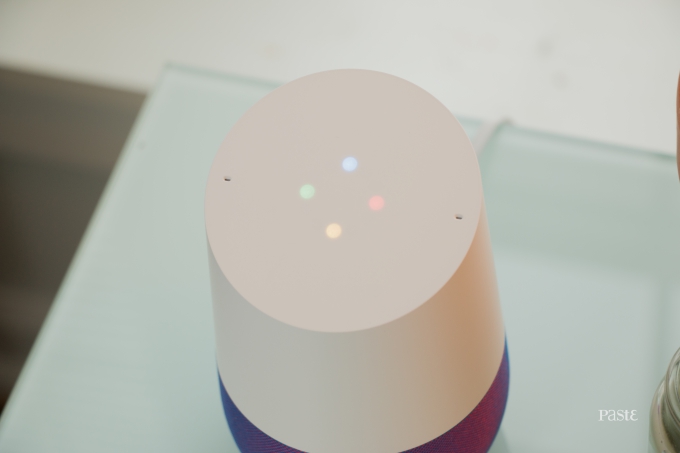 On the microphone side, the Home lags behind the Echo. Offering just two far-field microphones to the latter’s seven, Google’s speaker is making the statement that what Amazon has chosen is overkill. I haven’t compared the two directly, so I can’t make any assessment about which is better, but I can say the Home is, for the most part, pretty good at picking up my voice.
On the microphone side, the Home lags behind the Echo. Offering just two far-field microphones to the latter’s seven, Google’s speaker is making the statement that what Amazon has chosen is overkill. I haven’t compared the two directly, so I can’t make any assessment about which is better, but I can say the Home is, for the most part, pretty good at picking up my voice.
I have it placed in my living room, where my girlfriend and I spend the bulk of our time, on a table at one end of our sofa. Unsurprisingly, I have little trouble getting the Home to pick up my voice when I’m right next to it, but when sitting on the far end of the couch, with my voice projecting away from the device, results are mixed. Sometimes it picks me up fine and others it hears nothing.
What I’ve found is that I don’t yet have the confidence to not look at it while asking a query. When you say the key phrase, either “OK Google” or “Hey Google”, four colored lights appear, signaling that Home is ready to hear your command. Ideally, I shouldn’t have to peer at the speaker waiting for those colored lights to know that it’s heard me. I should just be able to say the key phrase and know that, barring any absurd distance or noise interference, it will hear me.
UPDATE: Turns out, you can know whether Google Home has heard you or not. Though sounds are turned off by default, users can activate them in the device’s settings within the Home app. It’s a little convoluted to find, but once you do, there are options for the Home to play a chime (the exact same one you hear on the Pixel when activating the Assistant) for both the start of a request and the end of one. No more having to look at the Home. Huzzah!
 As long as I was directing my voice toward the Home, and speaking at a volume at least above a whisper, it did a fine job picking me up and understanding what I was saying. Even over loud music, and once over a vacuum cleaner, the Home was able to find my voice amid the noise. As I have experience in the past, both with using voice in Google Search and then with the Google Assistant on the Pixel, the Home was accurate at parsing out what I was saying.
As long as I was directing my voice toward the Home, and speaking at a volume at least above a whisper, it did a fine job picking me up and understanding what I was saying. Even over loud music, and once over a vacuum cleaner, the Home was able to find my voice amid the noise. As I have experience in the past, both with using voice in Google Search and then with the Google Assistant on the Pixel, the Home was accurate at parsing out what I was saying.
Occasionally, it was way off the map which led to some humorous moments, but more often than not it nailed what I was saying. I do desperately wish I didn’t have to say the key phrase every time and that I could change the key phrase. The former may be improved on down the road, perhaps by implementing a second or two delay after one command where the speaker remains engaged, but I highly doubt the latter will change.
As for the speaker, it’s merely fine. Like the Echo, it will not stand up to some of the better Bluetooth offerings on the market, like the UE Boom 2, but it makes up for it with convenience. What you get sound wise is nothing special, it does fill a room nicely with little distortion at higher volumes, but otherwise it won’t impress seasoned audiophiles. Separation is subpar, the soundstage is narrow, bass response is average and the overall sound is muddier than I would like. Mids, highs and lows all run together.
 The benefit, of course, is the ease with which you can play music. It comes integrated with Google Play Music, YouTube Music, Pandora, TuneIn and Spotify, so all you have to do is choose your preferred music source and then ask Home to start playing music and it will. I used Spotify with my Home, and not only can you ask it to play a specific song or album, but also any playlists you have as well.
The benefit, of course, is the ease with which you can play music. It comes integrated with Google Play Music, YouTube Music, Pandora, TuneIn and Spotify, so all you have to do is choose your preferred music source and then ask Home to start playing music and it will. I used Spotify with my Home, and not only can you ask it to play a specific song or album, but also any playlists you have as well.
Even better, though, is the fact that Home works with Chromecast devices, meaning if you want to avoid the muddy sound of the Home, just connect a Chromecast Audio to existing speakers you have and then use Home to cast music. It’s a roundabout way to use your voice to start playing music when you could to the same thing with your phone, but it’s a nice option to have available.
Microphone inconsistency and poor speaker performance isn’t the prime concern with this device, however. That honor belongs to what you can do with it, or perhaps more appropriate, what it can do for you. Google Home is, like the Pixel smartphone, a vessel for the Google Assistant.
 Before discussing the Assistant on this device, it’s important to note that the Assistant here and the Assistant on the Pixel are not one and the same. There are things you can do with the phone version that you, inexplicably, cannot do on the connected speaker.
Before discussing the Assistant on this device, it’s important to note that the Assistant here and the Assistant on the Pixel are not one and the same. There are things you can do with the phone version that you, inexplicably, cannot do on the connected speaker.
So what can the Home do?
Well, it can:
– Set a timer
– Answer trivia questions, or basic searches
– Play games, like trivia and madlibs
– Play music through various services
– Cast videos and music to Chromecast connected devices
– Turn on your smart home gadgets (Works with Philips Hue, Nest, SmartThings and IFTTT)
– Add items to your shopping list (via Google Keep)
– Tell you what’s on your calendar
– Tell you the latest news and weather
– Make animal sounds so you can troll your cat
That all sounds pretty good, and it is pretty good. It’s also not a comprehensive list, so there are things Home can do that aren’t listed here, but this covers most of the basics. If it seems like a small list, that’s because it is.
Now let’s see what the Google Home can’t do, at least not yet.
It can’t:
– Send messages
– Offer movie showtimes near you
– Set a reminder
– Add events to your calendar
– Help you buy items online
– Allow multiple Google accounts to use it
– String commands together (i.e. Play a song via Spotify and set volume to 80 percent)
– Let you change the key phrase
– Let you stream via Bluetooth
– Throw non-YouTube videos to a Chromecast
– Take notes or voice memos
– Track packages
Again, this is not a comprehensive list, but there are a lot of surprising things that aren’t supported yet. Like reminders, or adding events to your calendar. Those are two basic functions that can be done with the Assistant on the Pixel, but not here.
There is an argument to be made that the lack of these basic functions are intentional. Unlike on the Pixel, the Google Assistant here is trained only to a key phrase, not to an individual voice. It’s meant to be used by anyone in the room, which means that anyone in my home could potentially add an event to my calendar or set a reminder for me or send a message were those features supported. That’s not ideal, but neither is not being able to use the Home for that purpose. Google has a lot of work to do to figure out these issues, along with the lack of multi-account support. The Home is supposed to be a personal assistant for everyone in the household, but it can’t do that when tied to a single account.
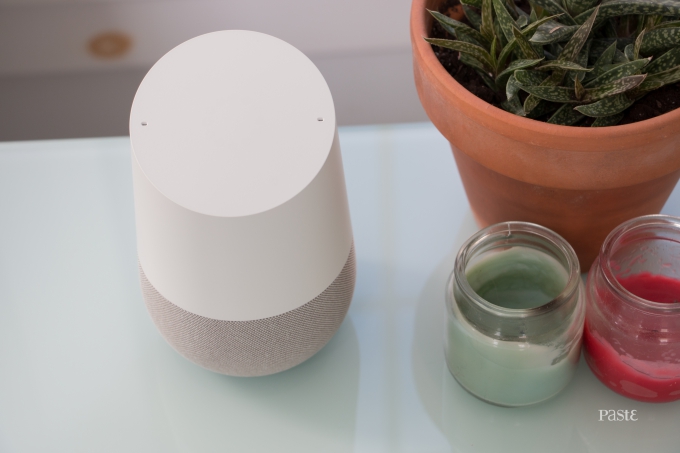 I don’t care so much about the things Home can’t yet do. Like the Assistant as a whole, the Home exists in a bubble of potential right now. It doesn’t do everything you’d hope, but it may be able to by this time next year. As an early adopter, and this is an early adopter gadget, you have to expect a few holes initially. I wish there were less holes, especially given the blueprint offered by the Echo, but I can live with the fact that it’s not an all-encompassing device at the moment.
I don’t care so much about the things Home can’t yet do. Like the Assistant as a whole, the Home exists in a bubble of potential right now. It doesn’t do everything you’d hope, but it may be able to by this time next year. As an early adopter, and this is an early adopter gadget, you have to expect a few holes initially. I wish there were less holes, especially given the blueprint offered by the Echo, but I can live with the fact that it’s not an all-encompassing device at the moment.
What frustrates me is when Google Home claims it can’t do something I know it can. Several times in the last few weeks I’ve asked Home to make an animal sound, for instance, and it has claimed not to be able to do so, though it absolutely can. It happened often enough for me to note the frustration, but was still a small percentage when considering all the times I asked Home to do something.
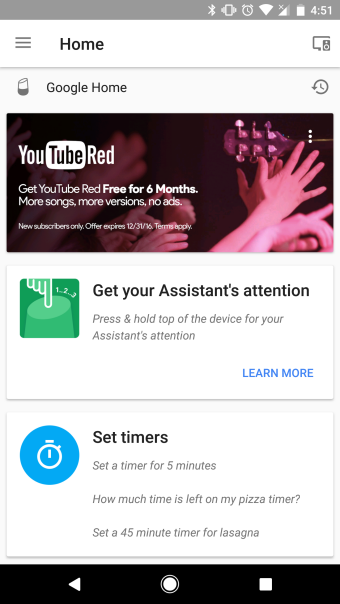 With the connected speaker comes the Home app, which is just a rebranded version of the Cast app. Within the application, you can adjust various settings, plus start and stop music, manage your smart home controls and more. It works well and is easy to use.
With the connected speaker comes the Home app, which is just a rebranded version of the Cast app. Within the application, you can adjust various settings, plus start and stop music, manage your smart home controls and more. It works well and is easy to use.
On the dark side of this conversation are the serious privacy concerns that come with an always-listening device. Google Home features the same obstacle in this space as that of the Echo, and Mountain View hasn’t provided a better roadmap to handling the balance between knowledge and privacy. If you want the Google Assistant to be the best possible assistant for you, it needs to know about your life.
Nonetheless, it’s a little awkward to know that Google very well may be stashing away your various searches and conversations with the Home. There is a space where each user can see what is being tracked, which may ease your concerns or enhance them. To combat this problem somewhat, Google included a manual mute button that can be pressed on the back of the speaker. It works just as you’d expect, and does offer a little ease of mind if there are particular conversations you absolutely don’t want Home to hear.
If the idea of a device like the Google Home sitting on a table in your living room concerns you, then you should wait until the company gives us a more clear-cut idea of what it is doing with all our information. But that may mean waiting forever.
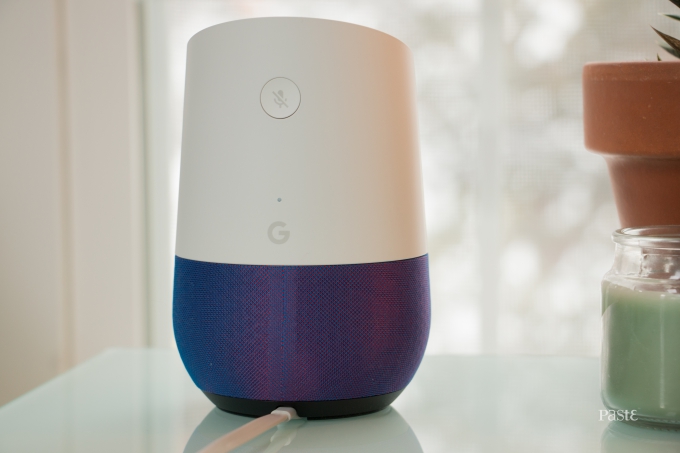 Like the Echo before it, the Google Home arrives as a device that feels only a step or two into its journey toward what it will eventually become. Unlike the Echo, and thanks to the Echo, we have more of an idea of what Home could be a year from now than we did when Amazon invented this hardware category.
Like the Echo before it, the Google Home arrives as a device that feels only a step or two into its journey toward what it will eventually become. Unlike the Echo, and thanks to the Echo, we have more of an idea of what Home could be a year from now than we did when Amazon invented this hardware category.
 Even in its current, barebones state, it’s a fun and exciting device. I use it to set timers, control my Philips Hue bulbs and find the answers to dumb questions. When it works, which is more often than not, it feels a little bit like magic. At $130, it’s cheaper than the Echo, but it’s not nearly the kind of impulse buy that a Chromecast is, nor is it a device that is a necessity. It’s a luxury, and will remain to be until it can find a way to be more useful to multiple people at once.
Even in its current, barebones state, it’s a fun and exciting device. I use it to set timers, control my Philips Hue bulbs and find the answers to dumb questions. When it works, which is more often than not, it feels a little bit like magic. At $130, it’s cheaper than the Echo, but it’s not nearly the kind of impulse buy that a Chromecast is, nor is it a device that is a necessity. It’s a luxury, and will remain to be until it can find a way to be more useful to multiple people at once.
If you’re excited about the connected speaker endeavor, about the idea of having a digital personal assistant in your house, the Google Home is the product for you. Given the amount of knowledge Mountain View already has thanks to 18 years of search data, the Home has the most potential moving forward. If you’ve been on the fence about the whole idea of connected speakers, there’s nothing the Home has yet that will impress you. If that’s your mindset, give it six months or a year and reassess.
But if you are interested in the idea of a connected speaker, and not certain about Amazon’s ability to improve the Alexa platform, buy the Home. There’s enough here to make it worth your $130 and with Google’s pedigree, it’s bound to improve over time.